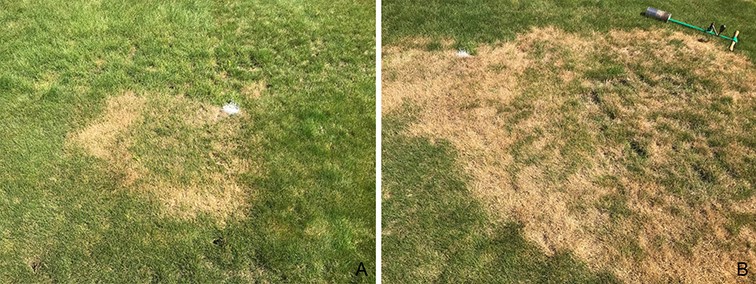By Jing Luo and Ning Zhang, Rutgers University
Summer patch is a damaging disease of turfgrasses that is most common in warm weather. It is caused by fungal pathogens that attack and colonize plant roots. Besides fine fescues, many types of turfgrasses, including bentgrass, Kentucky bluegrass, and annual bluegrass, are susceptible to this disease (Smiley et al. 2005).
The symptoms usually show during May through September and appear as small, scattered, light or pale green patches, typically 2 to 6 inches in diameter. The infected areas rapidly enlarge and fade to yellow or tan patches up to 1 to 3 feet in diameter, consisting of dead and dying plants. The patches may be re-colonized by resistant grasses or weeds in the centers, creating a “frog-eye” or “doughnut” appearance (Figure 1A). Patches may further coalesce, resulting in large and irregular shaped areas of infected turf that are several feet in diameter (Figure 1B).
Two fungal pathogens Magnaporthiopsis poae and Magnaporthiopsis meyeri-festucae are the main causal agents of summer patch of fine fescues but a few other fungi, such as Magnaporthiopsis incrustans, Slopeiomyces cylindrosporus, Gaeumannomyces avenae and Magnaporthiopsis cynodontis also are associated with this disease (Landschoot and Jackson 1989; Luo et al. 2017; Smiley et al. 2005; Vines et al. 2019). All these species belong to Magnaporthaceae, a fungal family close to the rice blast fungus. Their microscopic structures are similar (Figure 2), which makes the pathogen diagnosis difficult. To facilitate pathogen detection and identification, a molecular assay has been developed for one of the summer patch pathogens, M. poae, and more are forthcoming (Zhao et al. 2012). These molecular assays are fast (a few hours) and accurate, which enable early pathogen detection and will aid disease management.
References
Landschoot P.J., Jackson N. 1989. Magnaporthe poae sp. nov., a hyphopodiate fungus with a Phialophora anamorph from grass roots in the United States. Mycological Research 93(1):59-62.
Luo J., Vines P.L., Grimshaw A., Hoffman L., Walsh E., Bonos S.A., Clarke B.B., Murphy J.A., Meyer W.A., Zhang N. 2017. Magnaporthiopsis meyeri-festucae, sp. nov., associated with a summer patch-like disease of fine fescue turfgrasses. Mycologia 109(5):780-789.
Smiley R.W., Dernoeden P.H., Clarke B.B. 2005. Compendium of turfgrass diseases. American Phytopathological Society.
Vines P.L., Hoffmann F.G., Meyer F., Allen T.W., Luo J., Zhang N., Tomaso-Peterson M. 2019. Magnaporthiopsis cynodontis, a novel turfgrass pathogen with widespread distribution in the United States. Mycologia:1-12.
Zhao S., Clarke B.B., Shen Q., Zhang L., Zhang N. 2012. Development and application of a TaqMan real-time PCR assay for rapid detection of Magnaporthe poae. Mycologia 104:1250-1259.

